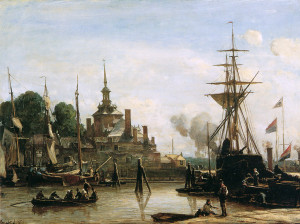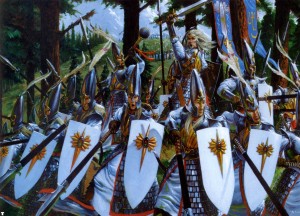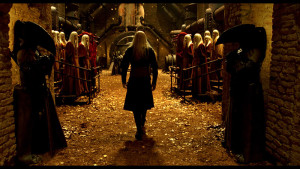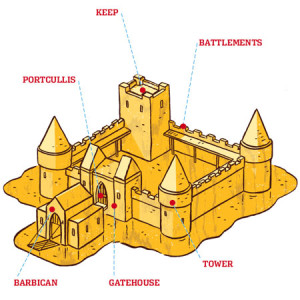[This is the (somewhat delayed) next post in a series dissecting the campaign ‘bible’ document I drafted while planning my AD&D 1e campaign. See here for an introduction to this series of posts.]
In Media Insulae

“View on Harbour Rotterdam Sun” by Johan Barthold Jongkind (1819-1891)
After the introductory remarks on the Curabel’s geography, my campaign bible zooms in to consider each of the three largest islands in the archipelago. First among these locations is the central island of Midland, home of the most powerful human-dominated city-state and my eventual choice for kicking off the first campaign in the setting. Given that this would seem to be the most mundane and ‘realistic’ of the Curabel population centers, I actually spent a good bit of time considering how to subvert player expectations without losing grip of verisimilitude completely. The key to achieving this was imagining what a failed colony of an imperialistic and mercantile nation would look like — in other words, a thought experiment about it would have been like if a major outpost of something like the Dutch East India Company decided to declare its independence*:
The “Middle Island” was the administrative seat of the colonial government. After the rebellion, it became the seat of power for the strongest human city-state (Midmark – founded by the disaffected naval commander who led the rebel forces against the imperial armada). Called Midland now, this island still has the largest port and naval base in the isles. Elves call this island Valmor (Tree Grave; Val = tree, mor = death) in reference to the many ship masts swarming the harbors, while the dwarves call it Xen’Khel (Far Fortress) since it was once their northernmost settlement. This isle is home to a fleet of merchant ships that facilitate trade throughout Curabel.
Several facts that could be translated into adventure hooks are established here: first, this location will be a prime spot for players interested in embarking upon ship-based and other aquatic endeavors; second, ruins and other locations associated with the imperial occupation should be easily accessible from this location; third, ruins from the ancient dwarven empire would exist nearby but would be from that civilization’s frontier. At the same time, I once again managed to work in some pseudo-linguistics that both extend the logic of one language (the dwarven use of Germanic compounds somewhat like Old English kennings) and indirectly characterize another culture (the specific metaphor used by the elves invoking the old tree-hugging clichés of the fantasy genre that I will soon be complicating).
Looking back now, it was probably a foregone conclusion that Midland would become the jumping off point for my first campaign set in Curabel. The clearest evidence of this is the very next paragraph, the only instance in this high-level overview of the islands’ geography in which I start to sketch out the specifics of a settlement — the city-state of Midmark, City of Gulls and natural powder-keg for simmering animosities between descendants of the colonial rebels and their erstwhile native islander allies:
Midmark proper is a large city, often called the City of Gulls, on the island’s main bay. While it may be mid-sized in comparison to some mainland imperial harbors, it is by far the largest urban center in Curabel and boasts a plethora of shops and other adventurer amenities. The city is divided into several districts, although businesses related to sea-faring can be found in all but the most upscale areas.
Most likely I was only resistant to the idea of committing to Midmark as the first adventure location because conventional wisdom claims that the ideal is to start players in a small settlement with equally small problems so that they can gradually discover the larger world and its more serious problems as they advance in level and become better able to deal with the greater danger. Keep on the Borderlands and Village of Hommlet certainly suggest that pattern implicitly, and later editions of D&D turn that implicit endorsement into explicit advice. The City of Gulls, on the other hand, is the political center of the islands with its superior naval force and “plethora of shops.” The logic of the conventional wisdom would suggest that starting PCs would be overwhelmed by the dangers and intrigues of a large city or relegated to bit-part players in a location that must (logically) have far more powerful NPCs. Of course, that kind of worry about artificial balance and careful DM shepherding seems anathema to general OSR ethos — after all, why wouldn’t prospective adventurers head to the biggest urban center available to them? Also, wouldn’t these adventurers be more likely to find employment opportunities commensurate to their skill level in a place where the forces of civilization have already eliminated the most hazardous dangers (if we exclude for a moment those more subtle dangers made possible by the mechanisms of civilization)? In fact, the next paragraph lays out a rationale for why a starting location near the center of civilization can make sense for low-level PCs:
In addition to Midmark, the dwarven fortress of Xenilum’Khel (“Second Farthest Fortress”) is located in a mountain called Ramithil on the western side of the large bay. It is new and relatively small relative to the great dwarven khels of Curasur; it is also very friendly with Midmark and travel/trade between the settlements is brisk. Further inland there is an older, abandoned dwarven fortress called Xen’Khel (“Far Fortress”) that has been picked over extensively by adventurous humans from Midmark and inquisitive dwarves from Xenilum’Khel. It is widely believed that the dwarves built their new fortress for more convenient access to the water and trade, but some voices whisper of dark secrets locked in ancient halls beneath Xen’Khel that have never been penetrated by post-imperial explorers.
Leaving aside for a moment the active dwarven settlement, a mega-dungeon in close proximity to a large city that has been picked over by previous adventurers seems no less appropriate for low-level PCs than a compact but pristine adventure site within walking distance from some backwater hamlet. In truth, though, I didn’t even need to go as far afield as Xen’Khel to provide adventure sites for my players and at this point in the campaign (50+ sessions) they will most likely be skipping those previously looted ruins for the “dark secrets locked in ancient halls.”
* One of the big inspirations for Midmark was the Neil Stephenson’s depiction of Amsterdam in his novel Quicksilver — in fact, many of my notes for the campaign’s first session borrowed imagery and language from that book (I especially liked the floating shipyard he describes). Amsterdam, of course, is the exact opposite of a company outpost but I would like to think it’s reasonable that if a Dutch East India Company settlement on the other side of the world did declare independence and slowly built up their own naval-centric city-state over a couple of centuries they would almost certainly end up mimicking their one-time home.
[Next in the series: Why AD&D’s standard, Tolkien-inspired elves undermine attempts to make a setting’s history meaningful yet mysterious and how I solved that problem while turning the race into Bolshevik-like political exiles]






